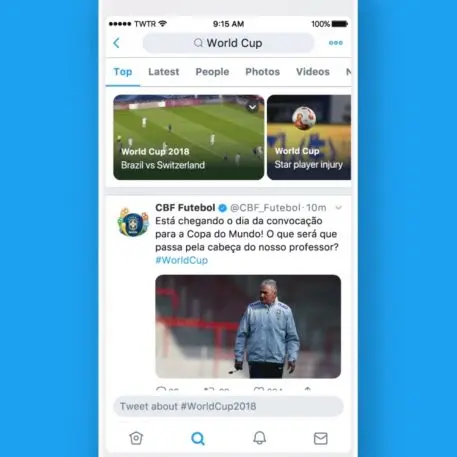Throughout this decade, Twitter has been a uniquely powerful way to keep up with the world’s news on a moment-by-moment basis. But that’s not the same thing as saying it’s been easy to use it for this purpose. It’s required careful management of your timeline, a willingness to traverse hashtags, and a familiarity with the service’s search features. The more effort you put into all this, the more news you got out.
To follow the Golden State Warriors, for instance, “you want to follow the players,” said Twitter VP of product Keith Coleman at a small press event at the company’s headquarters on Tuesday. “You want to follow the commentators. You want to follow Draymond Green’s mom. You want to follow the refs … But it’s kind of a lot of work to do that today.”
Now Twitter wants to take a more active hand in packaging up breaking news and ongoing events for consumption on its service. Via a combination of human curation and algorithms, it will collect together tweets, videos, and other elements about specific news events; fill your app with news about subjects it thinks you’re likely to care about; and attempt to ensure that you see the most important stories even if you’re not rummaging around for them.

All of this will arrive in the coming weeks and months, in multiple waves, across Twitter’s iOS, Android, and mobile web versions, and will be an ongoing work in progress. For instance, the company is already planning to refine the signals it uses to give every user a different selection of news based on what it can divine about their interests. “Currently, it’s mostly based on what you follow and what you tweet about, but that’s something we’re going to evolve a lot over time,” Coleman said.
These new features aren’t altogether new. They incorporate Moments—another curation approach which Twitter introduced in 2015–without entirely replacing them. And the company has been dabbling with some of its changes since last year for covering sports. Now it’ll apply the same approach to other types of news. (Starting on Thursday, it will also roll out ambitious World Cup-specific functionality with custom pages for every match; this, too, could be a template for future adjustments to how Twitter lets you follow other sorts of events, such as elections.)
On a higher level, making Twitter more approachable as a news source also builds out the vision that CEO Jack Dorsey has been emphasizing for a couple of years now—it was the subject of our October 2016 cover story-to make Twitter the world’s go-to source for coverage of events in real time. “Jack often says we want Twitter to be the little bird on your shoulder that tells you what you need to know, when you need to know it,” said Coleman. “That’s our ideal.”
The trouble with news
Twitter’s newly proactive approach to news comes at a time when social networks have been struggling with their roles as news distribution platforms. Facebook began the year by announcing that it would deemphasize content shared by publishers such as news organizations in users’ feeds. Then in February, conspiracy theories regarding the Parkland, Florida school shooting trended on Facebook, Instagram, and YouTube—a scenario the services failed to prevent even though it’s long been obvious that algorithms can be punked into helping hoaxes go viral. As for Twitter itself, it has long been inundated with propaganda bots masquerading as real people sharing news.
At Twitter’s media briefing, the company was light on the details of how it will ensure that its news upgrade won’t be hijacked for nefarious purposes, other than stressing that it involves a “blended” combination of humans and software. “We’re not a newsroom,” said director of curation Joanna Geary. “We’re not going to say ‘I wonder what the biggest issue is today, we’re going to commission something.’ We’re there to reflect conversations already going on on the platform.” Twitter doesn’t disclose how many employees it has on its curation team, but Geary did throw out a few stats: The company is curating news in 16 markets and five languages, with staffers in offices in eight cities.
Judging from Coleman and Geary’s comments at the press event, Twitter doesn’t look at the news features it’s introducing as potentially opening up a new Pandora’s Box of problems. Instead, they’ll reflect how the company is doing at tamping down bad actors in general. It’s been increasingly aggressive on that front: A month ago, for example, it began hiding more tweets based on algorithmic evidence that they might be trolls, bots, or trollish bots.
At the same time that Twitter has taken new measures against its worst users, it’s also kicked the can down the road a bit by declaring that it can’t truly gauge how it’s doing at improving the overall quality of tweets until it’s defined what it’s trying to achieve in a measurable way. The company has been soliciting advice from outside researchers and recently announced that it’s chosen finalists to help it tackle the challenge.
“You can judge a service like Twitter by a lot of metrics,” said Coleman. “The one that matters most to us is the health of the public conversation.” With its fresh approach to news, the company will have the opportunity to prove it’s making progress on a whole new front.
Recognize your brand’s excellence by applying to this year’s Brands That Matter Awards before the early-rate deadline, May 3.